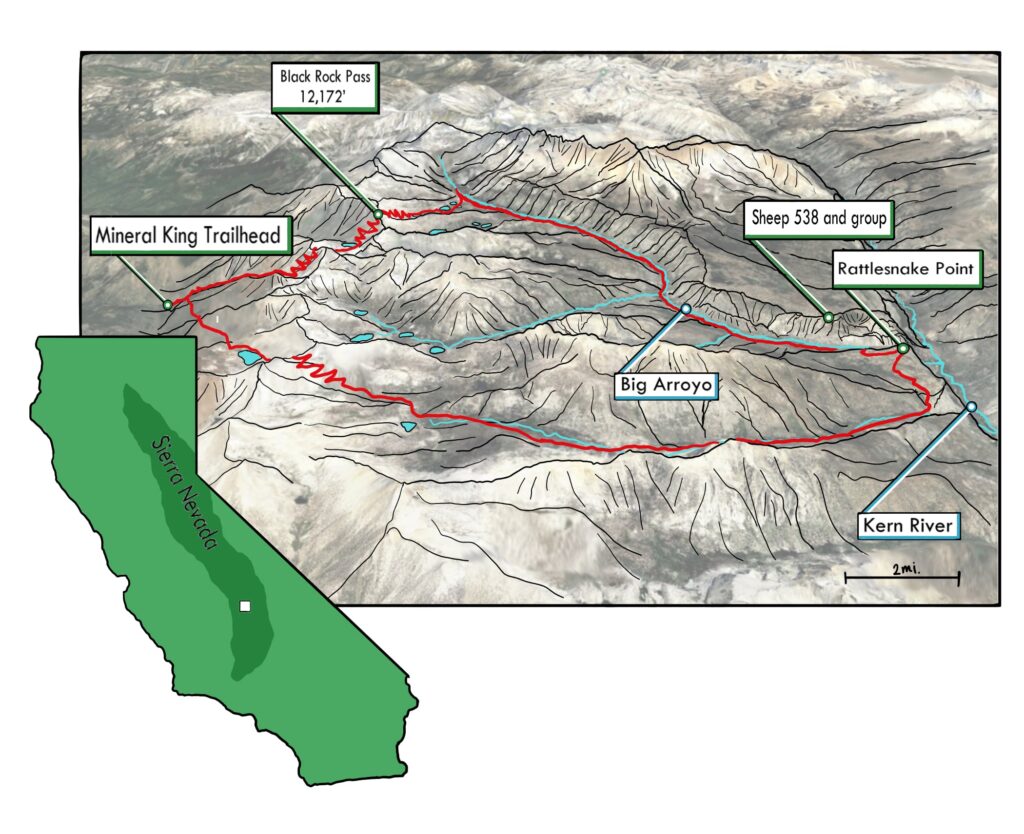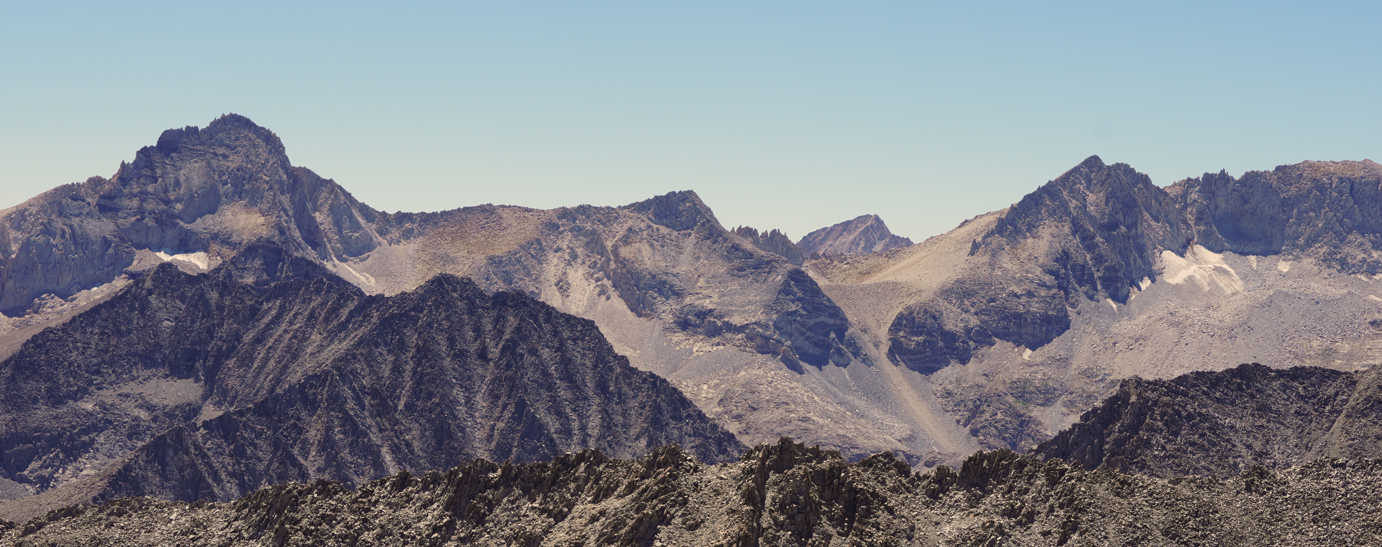From the Owens River Valley at 4,000 feet, the Sierra Nevada’s eastern slope explodes toward peaks reaching between 10,000 and 14,000 feet in just a few miles. While fairly regular in outline, the Sierra Nevada are not made up of smooth, straight edges nor are they a stagnant feature on the landscape. Since their formation by a series of uplift events and volcanic eruptions around the time the dinosaurs blinked out, the Sierras have been continually shaped by erosion, volcanism, and glaciation. This mountain range, like many in the west, has a way of humbling you. The vastness of the place, a sea of granite spreading in every direction, dwarfs the human presence. This feeling is amplified while searching for the remnant populations of Sierra bighorn that have endured both the natural and human-caused changes of the Sierra Nevada.

As I roll from my tent, my aching muscles and stiff joints remind me of the difficulties of studying bighorn sheep. Its day three of our approach to the Big Arroyo herd, a particularly remote group of Sierra bighorn that occupy the southeastern edge of Sequoia and Kings Canyon national park. Todd and I break camp and set out before the sun has crested the high peaks around the alpine basin we called home last night. We’re headed for the Kern River, which forms a deep incision dividing the Sierra Nevada into the main Crest and the Great Western Divide. Here along the steep cliffs of the Kern trench and its tributaries, we hope to find sheep.
We choose a spot on an exposed knob above the Big Arroyo, a glacial fed arm of the Kern, from which this herd draws its name. Rummaging through chaotically “organized” packs, we extract our telemetry equipment which picks ups radio signals emitted from a transmitter attached to the sheep of interest. We can a hear a signal coming from one of our collared ewes—she should be within our line of sight. We temper our excitement; we know that the signals from these collars have a way of bouncing along these steep canyons walls as well as the sheep do.
We begin the slow monotonous scans of the rock face across the canyon. Even with our 60x spotting scopes, the rocks have a way of growing horns. Hours pass, our bodies cramp from our hunched position while our hands, the only bit of skin we leave exposed to the harsh alpine radiation, sweat and burn. We listen for the collar’s signal and reposition over and over hoping to reveal a new crease in the cliff face that might be hiding the white woolen “whale”. Our eye lids, mirroring our hopes, sag with each additional pass.
Unexpectedly our radio crackles. Lacey and Elsbeth—another survey party is within range across the canyon. We split up on day two so we could each scan the steep canyon walls below the other.
Lacey: “Jaron, Todd. It’s Lacey, do you copy?”
A delay as we fumble for our radio while our eyes adjust from squinting through our scopes.
Todd (groggy): “Yeah, go ahead Lacey.”
Lacey: “We’ve got a strong signal from 538 in the bowl at the mouth of the canyon”
Surprised, we recheck our signal. Another delay. We can’t let ourselves believe we’ve been deceived again.
Jaron: “Hey Y’all. We hear that too, but it’s tough to tell in here what’s bounce or not. We’ve covered the upper canyon pretty well; we’ll reposition and see if we can help you out”
Elsbeth: “Copy that”
We pack up our scopes and tripods and begin to pick our way down stream. Remembering the grace with which bighorn sheep move from crag to crag, reminds us of our fumbling nature and newcomer status.
The bowl begins to open itself to us, but our view is broken by the snags of ponderosa pine crippled by ever worsening drought and the incessant munching of the mountain pine beetle. We decide to make do and again, unearth our scopes and telemetry equipment. Suddenly our radio explodes:
Lacey: “Jaron, Todd, we’ve got a visual. Top of the bowl, east side.”
Our spirts rise. Briefly.
Lacey: “There’s seep of moisture just west of…”
The radio cuts out.
Lacey: “They’re on the move. Headed west. Fast.”
Todd rushes to get the legs under the scope and keep his from shaking. I reposition and opt for binoculars to help Todd zone in.
Elsbeth: “Jaron, Todd, do you have them?”
Todd: “Not yet. Where are they?”
Lacey: “Crossing the talus in the middle of the bowl. We’re going to lose them below us.”
Jaron: “Lacey, did you get a count? How about group composition?”
Lacey: “12 maybe 13. Tough to tell they keep bunching up.”
Jaron: “I’m on ‘em. They’re coming out of the bottom just below that brushy gully.”
Todd:” Jaron, what’s your count?”
Jaron: “Give me a second.”
Lacey: “We got 7 adult females, 5 lambs, 1 yearling female. Tough to say though, I think we missed some. We’re moving to try and reposition.”
Todd: “Okay, I got em, but they’re headed for some timber. I don’t think we have long.”
Elsbeth: “What do you have?”
Jaron: “13.”
Todd: “14. Shit.”
Jaron: “They’re about to crest the ridge on the west side of the bowl.”
Todd: “6 adult females, 5 lambs, 1 yearling female, 2 yearling males?”
Lacey: “We’re back on ‘em. You think that last one is a ram?”
Todd: “Could be an adult female. I can’t see the base of the horns”
Elsbeth: “14, definitely 14”
Jaron: “They’re about to reach the tree line, were almost out of time.”
Todd: “I can’t get another count. They’re gone.”
Lacey: “7 adult females, 5 lambs, 1 yearling female, 1 adult male. I got a good look as they spread out going into the trees. I think that’s our count.”
I can practically hear Lacey and Elsbeth sigh from across the canyon, as Todd and I do the same.
It’s not the survey any of us wanted, but despite all the effort it takes to get here, sometimes there is only a flash.
The next morning, we stretch and groan before shouldering our packs for the long hike out. Climbing over peak and pass we begin to extract ourselves from this deep canyon and our own deep frustration. The effort for us to observe these animals is nothing compared to the effort they’ve needed to persist in this vast wilderness. Like the other subspecies, Sierra bighorn were once prolific throughout their range. Now it often feels like searching for a needle in a haystack. This herd in the Big Arroyo is small but thriving, perhaps benefitting as much from their remoteness as we struggle with it.

